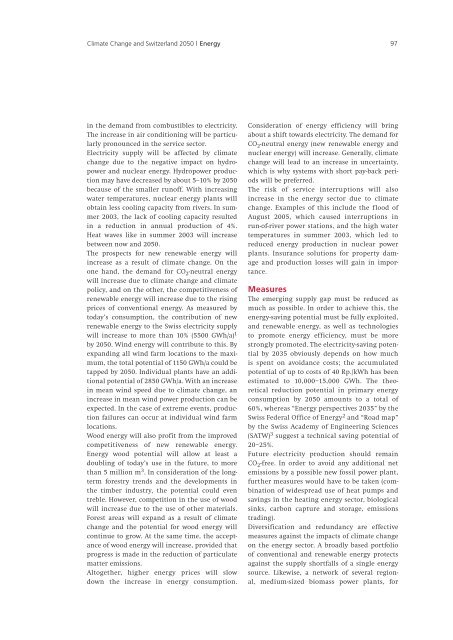Climate Change and Switzerland 2050 - OcCC - SCNAT
Climate Change and Switzerland 2050 - OcCC - SCNAT
Climate Change and Switzerland 2050 - OcCC - SCNAT
You also want an ePaper? Increase the reach of your titles
YUMPU automatically turns print PDFs into web optimized ePapers that Google loves.
<strong>Climate</strong> <strong>Change</strong> <strong>and</strong> Switzerl<strong>and</strong> <strong>2050</strong> | Energy 97<br />
in the dem<strong>and</strong> from combustibles to electricity.<br />
The increase in air conditioning will be particularly<br />
pronounced in the service sector.<br />
Electricity supply will be affected by climate<br />
change due to the negative impact on hydropower<br />
<strong>and</strong> nuclear energy. Hydropower production<br />
may have decreased by about 5–10% by <strong>2050</strong><br />
because of the smaller runoff. With increasing<br />
water temperatures, nuclear energy plants will<br />
obtain less cooling capacity from rivers. In summer<br />
2003, the lack of cooling capacity resulted<br />
in a reduction in annual production of 4%.<br />
Heat waves like in summer 2003 will increase<br />
between now <strong>and</strong> <strong>2050</strong>.<br />
The prospects for new renewable energy will<br />
increase as a result of climate change. On the<br />
one h<strong>and</strong>, the dem<strong>and</strong> for CO 2-neutral energy<br />
will increase due to climate change <strong>and</strong> climate<br />
policy, <strong>and</strong> on the other, the competitiveness of<br />
renewable energy will increase due to the rising<br />
prices of conventional energy. As measured by<br />
today’s consumption, the contribution of new<br />
renewable energy to the Swiss electricity supply<br />
will increase to more than 10% (5500 GWh/a) 1<br />
by <strong>2050</strong>. Wind energy will contribute to this. By<br />
exp<strong>and</strong>ing all wind farm locations to the maximum,<br />
the total potential of 1150 GWh/a could be<br />
tapped by <strong>2050</strong>. Individual plants have an additional<br />
potential of 2850 GWh/a. With an increase<br />
in mean wind speed due to climate change, an<br />
increase in mean wind power production can be<br />
expected. In the case of extreme events, production<br />
failures can occur at individual wind farm<br />
locations.<br />
Wood energy will also profit from the improved<br />
competitiveness of new renewable energy.<br />
Energy wood potential will allow at least a<br />
doubling of today’s use in the future, to more<br />
than 5 million m 3 . In consideration of the longterm<br />
forestry trends <strong>and</strong> the developments in<br />
the timber industry, the potential could even<br />
treble. However, competition in the use of wood<br />
will increase due to the use of other materials.<br />
Forest areas will exp<strong>and</strong> as a result of climate<br />
change <strong>and</strong> the potential for wood energy will<br />
continue to grow. At the same time, the acceptance<br />
of wood energy will increase, provided that<br />
progress is made in the reduction of particulate<br />
matter emissions.<br />
Altogether, higher energy prices will slow<br />
down the increase in energy consumption.<br />
Consideration of energy efficiency will bring<br />
about a shift towards electricity. The dem<strong>and</strong> for<br />
CO 2-neutral energy (new renewable energy <strong>and</strong><br />
nuclear energy) will increase. Generally, climate<br />
change will lead to an increase in uncertainty,<br />
which is why systems with short pay-back periods<br />
will be preferred.<br />
The risk of service interruptions will also<br />
increase in the energy sector due to climate<br />
change. Examples of this include the flood of<br />
August 2005, which caused interruptions in<br />
run-of-river power stations, <strong>and</strong> the high water<br />
temperatures in summer 2003, which led to<br />
reduced energy production in nuclear power<br />
plants. Insurance solutions for property damage<br />
<strong>and</strong> production losses will gain in importance.<br />
Measures<br />
The emerging supply gap must be reduced as<br />
much as possible. In order to achieve this, the<br />
energy-saving potential must be fully exploited,<br />
<strong>and</strong> renewable energy, as well as technologies<br />
to promote energy efficiency, must be more<br />
strongly promoted. The electricity-saving potential<br />
by 2035 obviously depends on how much<br />
is spent on avoidance costs; the accumulated<br />
potential of up to costs of 40 Rp./kWh has been<br />
estimated to 10,000–15,000 GWh. The theoretical<br />
reduction potential in primary energy<br />
consumption by <strong>2050</strong> amounts to a total of<br />
60%, whereas “Energy perspectives 2035” by the<br />
Swiss Federal Office of Energy 2 <strong>and</strong> “Road map”<br />
by the Swiss Academy of Engineering Sciences<br />
(SATW) 3 suggest a technical saving potential of<br />
20–25%.<br />
Future electricity production should remain<br />
CO 2-free. In order to avoid any additional net<br />
emissions by a possible new fossil power plant,<br />
further measures would have to be taken (combination<br />
of widespread use of heat pumps <strong>and</strong><br />
savings in the heating energy sector, biological<br />
sinks, carbon capture <strong>and</strong> storage, emissions<br />
trading).<br />
Diversification <strong>and</strong> redundancy are effective<br />
measures against the impacts of climate change<br />
on the energy sector. A broadly based portfolio<br />
of conventional <strong>and</strong> renewable energy protects<br />
against the supply shortfalls of a single energy<br />
source. Likewise, a network of several regional,<br />
medium-sized biomass power plants, for

















